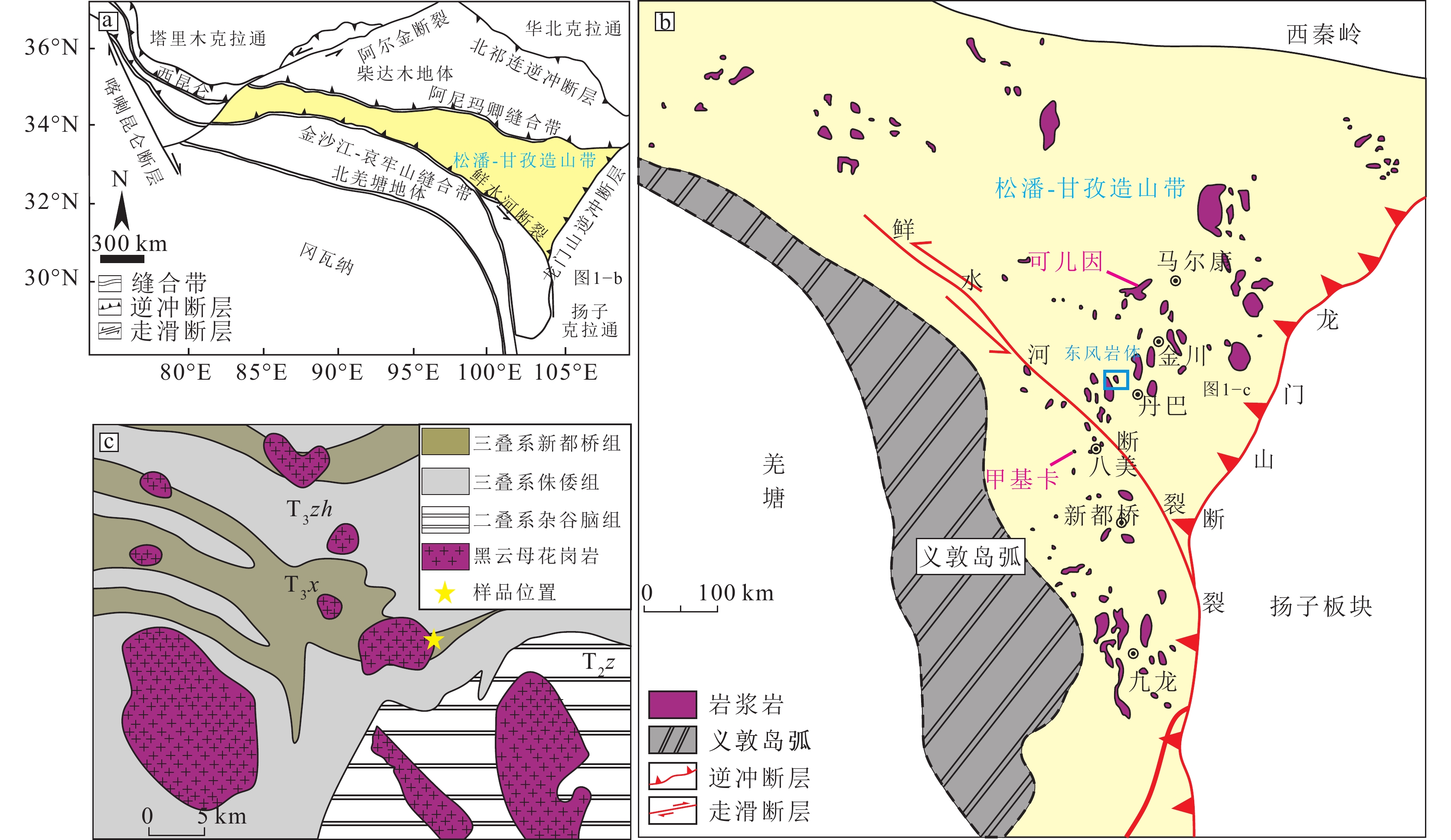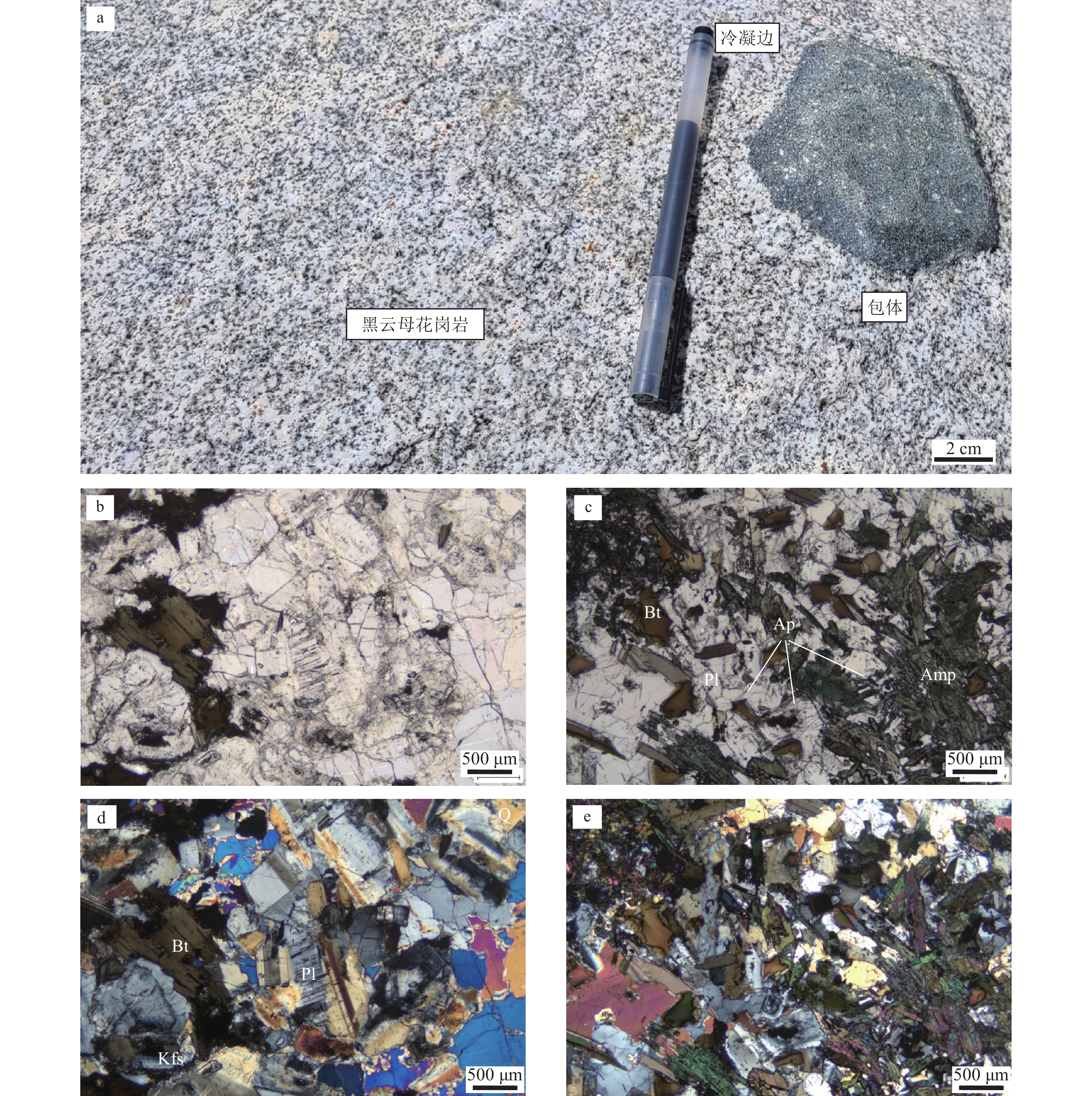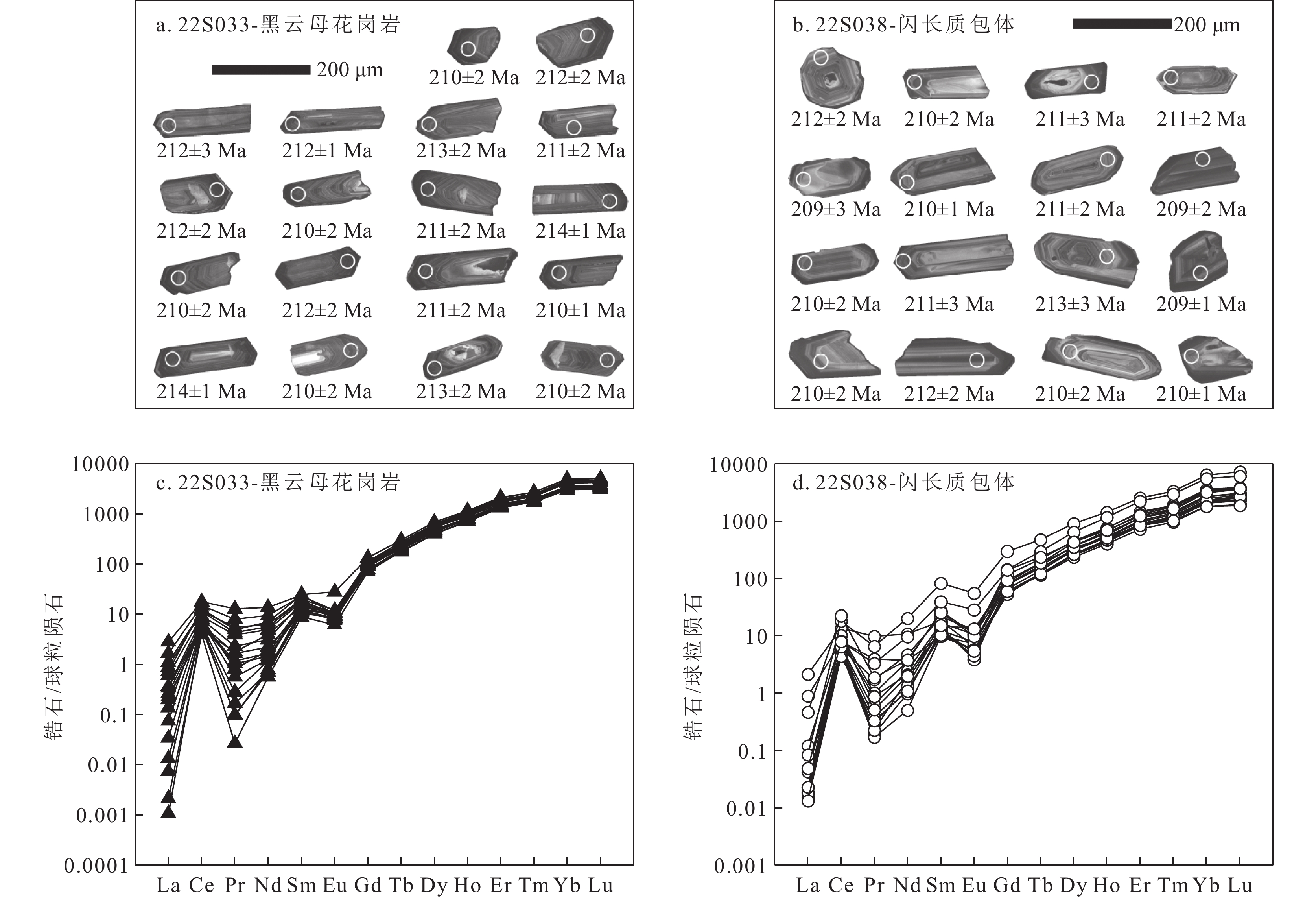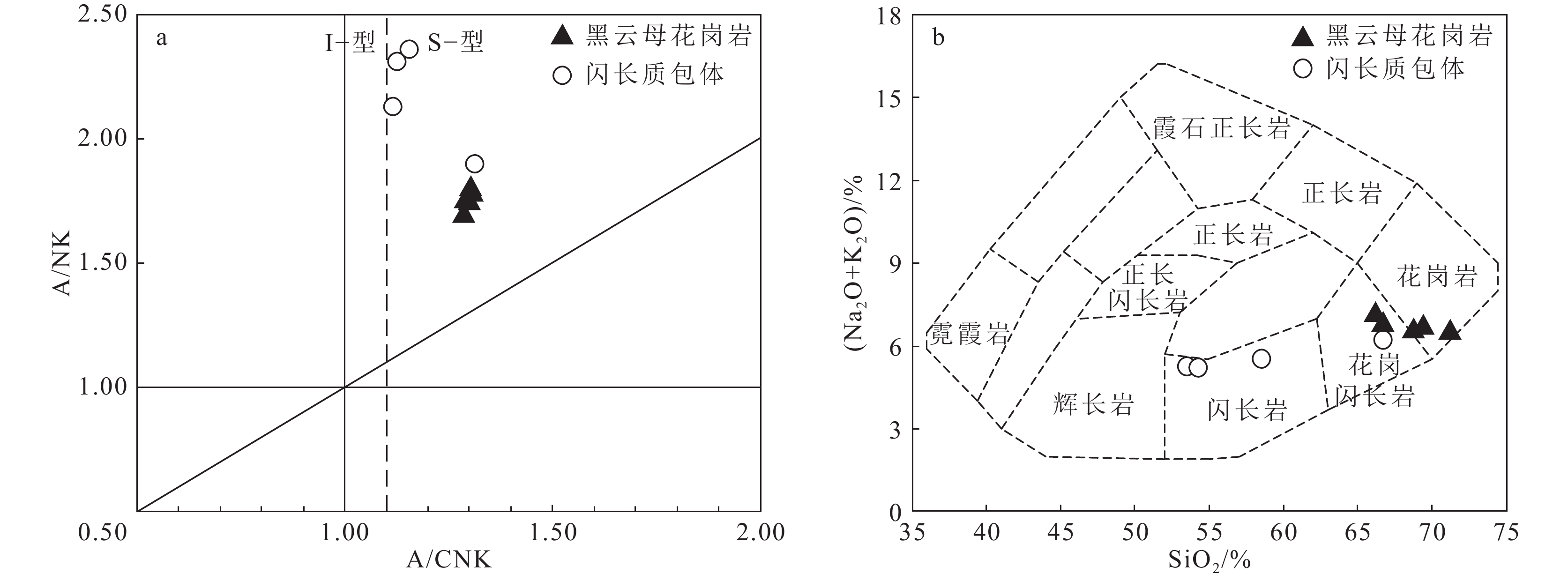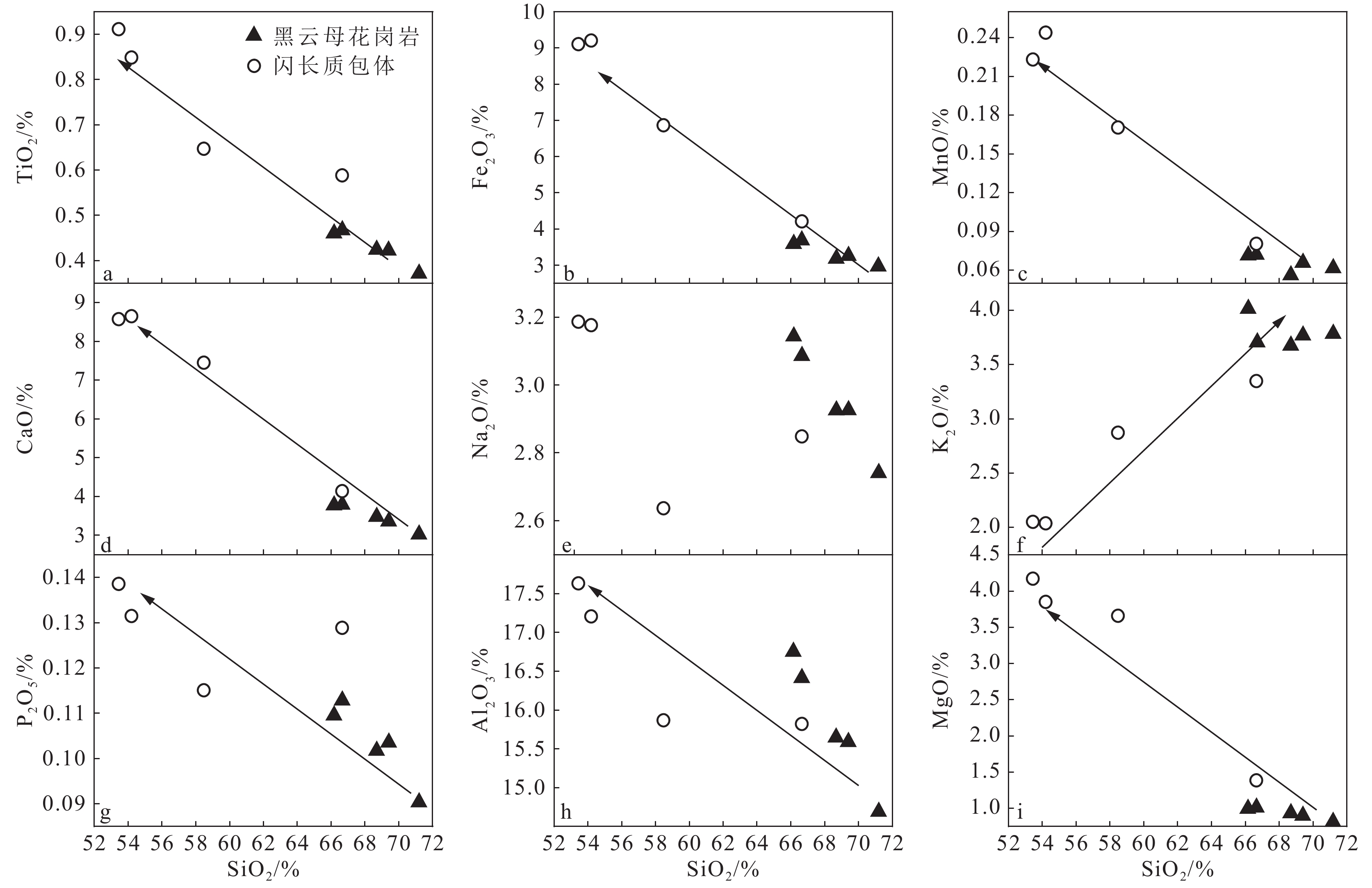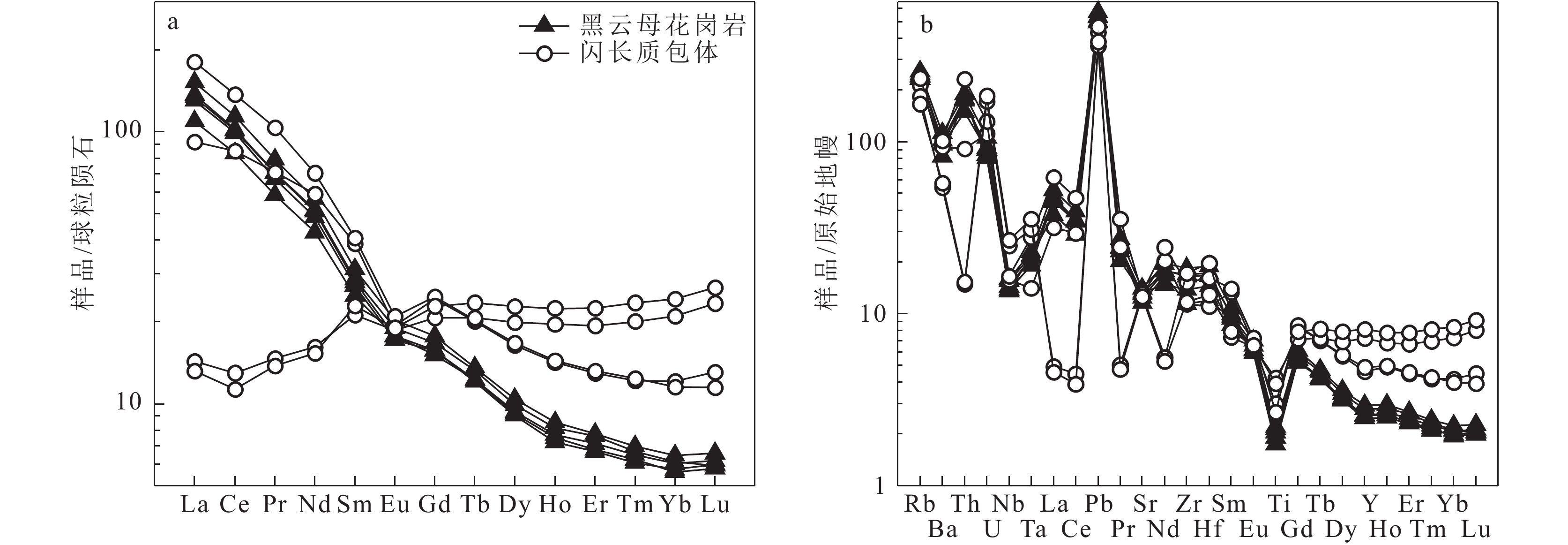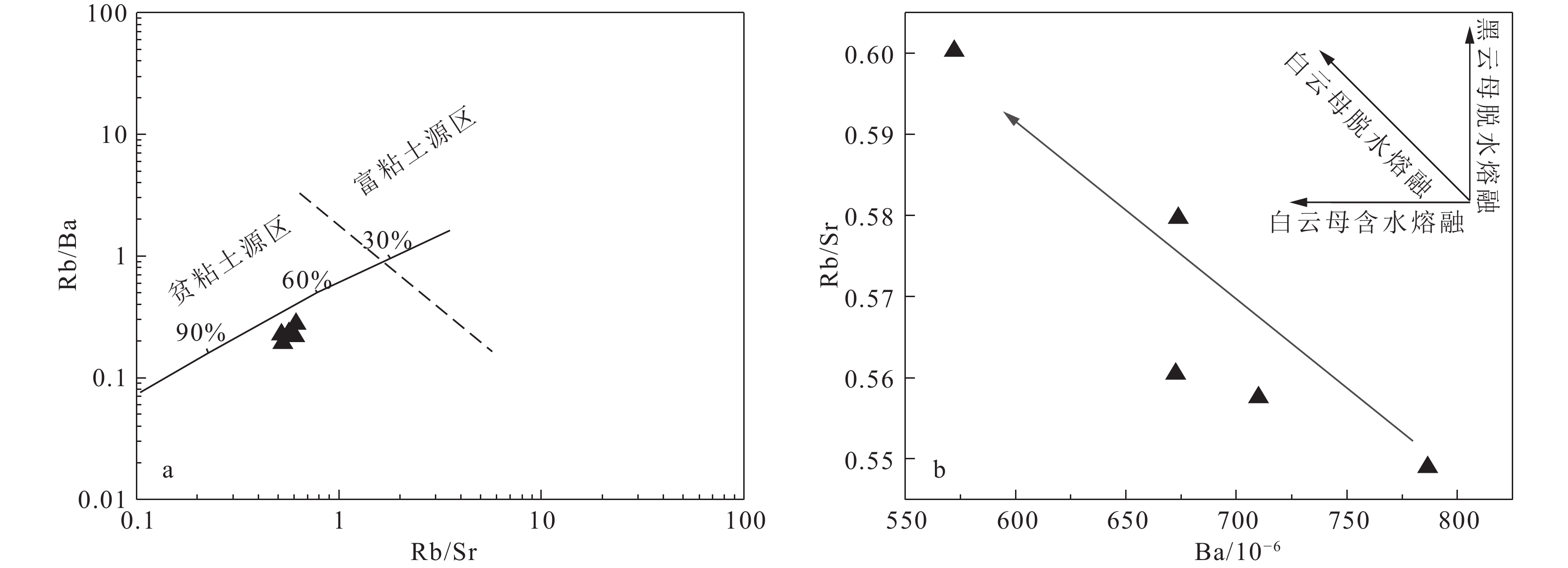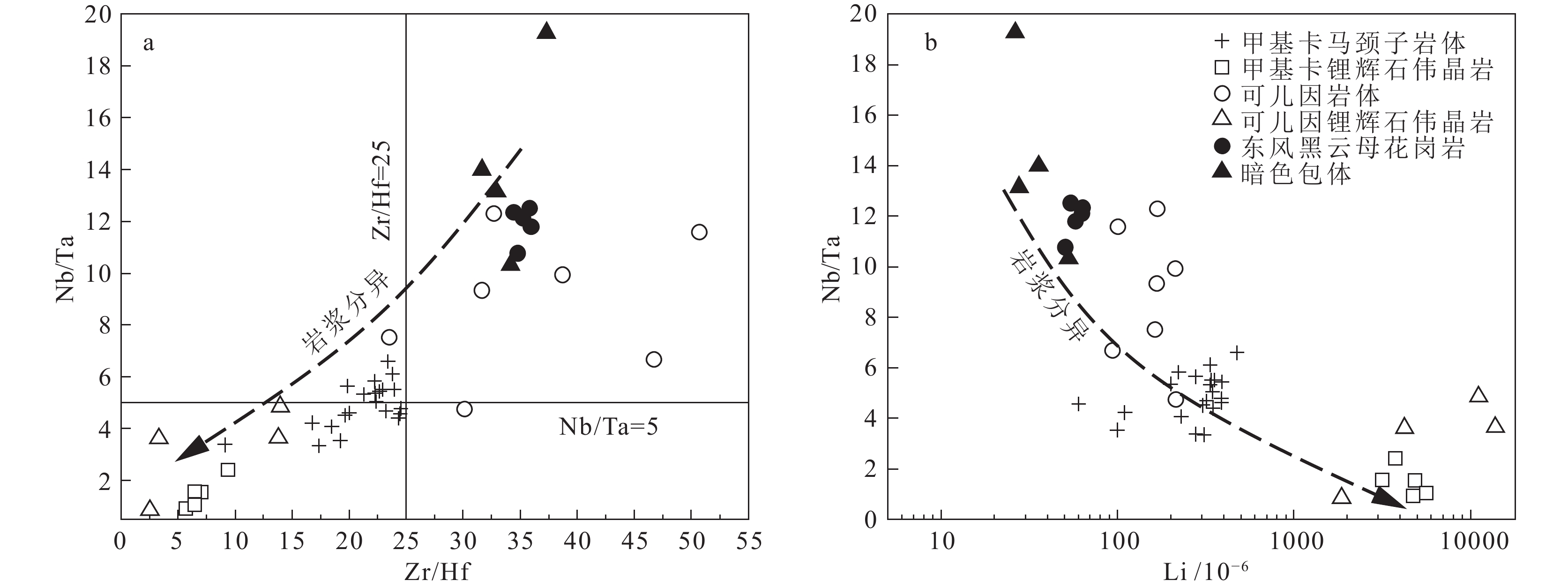Petrogenesis of the Dongfeng granite and its dioritic enclave: Implications for the Triassic magmatism in the Songpan−Ganzi Orogenic Belt
-
摘要:
松潘−甘孜造山带已成为中国重要的锂多金属成矿带,多金属成矿作用与该地区晚三叠世—早侏罗世花岗质岩浆活动密切相关。岩浆演化的复杂过程导致了这些花岗岩的地球化学多样性。暗色包体在花岗岩的形成演化中扮演了重要角色,然而对于这些暗色包体在松潘−甘孜造山带花岗岩形成过程中的作用及对岩浆系统中Li的贡献目前知之甚少。东风岩体是松潘−甘孜造山带东部含有大量闪长质暗色包体的典型花岗岩体。锆石U−Pb定年结果显示,黑云母花岗岩和闪长质包体的结晶年龄分别为211.8 ± 1.0 Ma和210.5 ± 1.1 Ma。黑云母花岗岩具有富硅、过铝质,以及低Rb、Rb/Sr和Rb/Ba的特征,且具有明显富集的锆石εHf(t) (−10.2~−5.9)、较高的初始Sr同位素组成((87Sr/86Sr)i = 0.7117~0.7118)及富集的εNd(t) (−9.7~−9.3),指示形成于中上地壳杂砂岩部分熔融。闪长质包体具有高Mg、Ca、Cr和Ni的特征,相对亏损的锆石Hf同位素(εHf(t) = −9.6~−1.3)和全岩Nd同位素(εNd(t) = −9.5~−8.8),以及低放射成因Sr同位素((87Sr/86Sr)i = 0.7108~0.7113),指示起源于受软流圈地幔改造的下地壳源区。黑云母花岗岩斜长石斑晶和闪长质包体中斜长石斑晶从核部向边部An值急剧变化,揭示了长英质岩浆和镁铁质岩浆的混合作用。闪长质包体具有低的Li含量(26×10−6~52×10−6),反映松潘−甘孜造山带锂矿成矿物质与下地壳或更深部的地幔物质无关。
Abstract:The Songpan−Ganzi Orogenic Belt has emerged as a prominent Li−polymetallic metallogenic belt in China, characterized by polymetallic mineralization intricately associated with granitic magmatism during the Late Triassic to Early Jurassic period. The complicated magma evolution has resulted in the geochemical diversity of these granites. Enclaves play an important role in the formation of granite. However, it is still enigmatic about the role played by enclaves in the formation of granite within the Songpan−Ganzi Orogenic Belt, as well as their contribution to Li in the magmatic system. The Dongfeng pluton, located in the eastern part of the Songpan−Ganzi Orogenic Belt, is a typical granitoid that contains numerous enclaves. Zircon U−Pb dating yielded crystallization ages of 211.8 ± 1.0 Ma for the biotite granite and 210.5 ± 1.1 Ma for the dioritic enclave. The biotite granite is characterized by high−Si and prealuminous, alongside low Rb content, Rb/Sr and Rb/Ba ratios. Furthermore, it displays negative zircon εHf(t) values ranging from −10.2 to −5.9, notably high (87Sr/86Sr)i ratios between 0.7117 and 0.7118, and negative εNd(t) values of −9.7 to −9.3. These features suggest that the parental magma derived from the partial melting of meta−sediments within the upper to middle crust. These dioritic enclaves display high concentrations of Mg, Ca, Cr and Ni, and relatively slightly depleted zircon Hf isotopes (εHf(t) = −9.6 to −1.3) and whole−rock Nd isotopes (εNd(t) = −9.5 to −8.8), as well as lower radiogenic Sr isotopes ((87Sr/86Sr)i = 0.7108~0.7113). This indicates a lower crustal source that had undergone modifications by asthenospheric mantle materials. The pronounced variations in An values from core to rim of the plagioclase phenocrysts from the biotite granite and dioritic enclaves provides compelling evidence for mixing process involving felsic and mafic magmas. The dioritic enclaves exhibit a low Li content (26×10−6~52×10−6), reflecting that the lithium deposits in the Songpan−Ganzi Orogenic Belt are not contributed by the lower crust or deeper mantle materials.
-
地下水污染可对饮用水安全、人体健康和社会可持续发展产生严重影响。2021年12月1日,国务院颁布实施《地下水管理条例》(中华人民共和国国务院令第748号),表明国家对于地下水污染防治工作高度重视。防控地下水污染,开展源头保护是重中之重。地下水污染具有隐蔽性,因此开展地下水污染溯源和解析显得尤为重要。为了有效识别和解析地下水污染,需要采用科学的方法和技术,结合现场调查和实验分析,确定污染物的来源、性质、分布等信息。传统方法,如水化学离子分析法、同位素法、主成分分析法等已经被广泛应用(闫颖等,2020;Huang et al.,2021;马春龙等,2021),但也存在一定的局限性。近年来,随着科技的进步和新型方法的发展,如模拟优化法、正定矩阵因子分析模型,以及决策树、随机森林、自组织映射技术等人工智能领域的方法,为地下水污染源解析提供了新的思路和手段(林斯杰等,2020;Constantinos et al.,2022;Hamed et al.,2022;许明明等,2022)。
本文重点介绍目前较成熟的同位素法、荧光光谱法、主成分分析法、地质统计学法,以及新发展的正定矩阵因子分析模型和自组织映射技术在地下水污染源解析中的应用,阐述这些方法在地下水污染源解析中的原理、适用性、优缺点等,探讨不同方法间的联合应用和发展前景,为地下水污染源解析工作提供参考。
1. 源解析方法综述
1.1 同位素法
同位素是具有相同原子序数的同一化学元素的2种或多种原子之一,不同环境水体由于成因不同而具有不同特征的同位素组成。通过分析不同环境中水体同位素的“痕迹”,可以判断其形成和转移,进而判断地下水污染程度、污染物来源等(杨琰等,2004;张应华等,2006;李先国等,2009;庞凤梅等,2011;闫颖等,2020;赵然等,2020)。在地下水污染源解析研究中,硝酸盐、硫酸盐、金属等同位素方法多年来已被国内外学者多次应用。
硝酸盐同位素是一类很常用的同位素法。硝酸盐是地下水中常见的污染物,而不同来源的硝酸盐在化学形式上很难区分。氮氧同位素技术是识别具有不同同位素组成的硝酸盐污染的直接手段(杨琰等,2004),它可以根据不同来源的同位素特征值进行地下水污染源解析。Torres et al.(2020)使用同位素示踪剂结合贝叶斯同位素混合模型,对墨西哥蒙特雷河谷的地下水硝酸盐和硫酸盐污染进行跟踪,判断其污染的不同来源和转化过程,研究结果表明,蒙特雷河谷地下水中硝酸盐和硫酸盐的污染来源主要为城市污水渗漏。Huang et al.(2021)利用多元同位素(δ15N-NO3、δ34S-SO4、δ18O-SO4、δ13C-DIC)研究了Piedmont地区的山前冲积扇地下水硝酸盐污染,得出粪便/污水是补给区非承压和承压地下水中硝酸盐的主要来源,证明了使用多种同位素技术阐明硝酸盐来源及其在地下环境中迁移途径的可行性。根据国内外研究总结的硝酸盐氮氧同位素值域见表1(吴娜娜等,2017)。由于氮氧双同位素法无法考虑空间变异、反硝化过程中的同位素分馏和混合物可能存在的多个来源等问题,近年来通常使用贝叶斯同位素混合模型(Stable Isotope Analysis in R,简称SIAR)。将多元同位素与SIAR模型相结合,可以消除硝化、反硝化或挥发过程中可能存在的不确定性,从而定量分析硝酸盐的污染来源及其转化过程(Torres et al.,2021)。
表 1 不同污染源硝酸盐氮氧同位素值域范围(据吴娜娜等,2017)Table 1. The range of nitrogen and oxygen isotope ratios of nitrate from various pollution sources污染源 δ15N 典型值域范围/‰ 均值/‰ 大气NO3−沉降 −7.7 ~ +5.8 −0.4 大气NH4+沉降 −11.1 ~ +2.3 −4.3 粪肥 +5.9 ~ +22.0 +12.7 污水 +4.6 ~ +18.4 +11.4 土壤氮 −3.5 ~ +9.0 +2.2 NO3−化肥 −2.7 ~ +2.3 0 NH4+化肥 −2.0 ~ +4.0 +0.3 污染源 δ18O 典型值域范围/‰ 均值/‰ 大气沉降作用 +25.0 ~ +75.0 +54.2 硝态氮肥 +18.0 ~ +25.7 +21.7 土壤微生物硝化作用 +3.5 ~ +16.8 +10.6 硫酸盐同位素由于指示能力较好,经常与氮氧同位素一起应用,图1为地下水中不同来源的δ34S-SO4 和 δ15N-NO3典型值,两者结合应用可以对受硝酸盐和硫酸盐混杂污染的场地起到更好的指示作用。Li et al.(2006)研究四川盆地地下水、雨水和煤中硫酸盐的δ34S,得到了地下水硫酸盐的主要来源为雨水、人类农业活动等。铬、铅、硼等稳定同位素也在工业生产、矿山污染等重金属相关的地下水污染源解析中存在一定应用(Cheng et al.,2010;郝红等,2013;Nisi et al.,2016;Kanagaraj et al.,2018)。此外,Voltaggio et al.(2015)使用氢、氧、锶、铀、镭等放射性同位素调查污染井中高盐度的来源,并考虑了镭同位素在地下水研究中的2种作用,包括作为示踪剂分析水岩相互作用及用228Ra与226Ra的比率评估地下水在浅水区的停留时间。
有机单体同位素分析(Compound-specific Isotope Analysis,简称CSIA),是分子有机地球化学和同位素地球化学互相渗透交叉的产物,可诊断有机污染来源(Schmidt et al.,2004;刘国卿等,2004)。CSIA技术可以连续测定气相色谱流出的每一个生物标志化合物碳、氢稳定同位素的组成,可成为污染物来源判识与过程示踪的有力工具。随着科技的发展,该技术可以进行氮、氧、氯、氢等单体稳定同位素的检测,也可被广泛应用于多环芳烃、氯代烃、农药残留物、农用化学品等有机污染物的检测研究中。此外,它已经在一些典型的污染场地中成功识别出有机污染物的来源(Glaser,2005;张琳等,2009;王晓红等,2013;左海英,2015)。
综上所述,同位素法由于涵盖元素广、分析结果精确、可参考经验数值多等原因,在地下水污染源解析中有着十分广泛的应用。在农业化肥污染、生活污水、工业污染等人为源污染造成的地下水污染中,硝酸盐同位素法和硫酸盐同位素法都是比较常用且精确的定量解析方法,但实际应用时存在同位素比值重叠的问题(王会霞等,2021),而且相比于一些多元统计学方法,需要耗费更多的成本和时间,为了解决这一问题,在硝酸盐转化过程中几乎不发生同位素分馏的硼同位素可以与硝酸盐、硫酸盐同位素联合使用(Frank et al.,2012)。铅和铬同位素在实际环境中通常受外界影响变化较小,因此在环境同位素示踪中得到广泛应用,但目前应用在地下水源解析的案例较少。CSIA技术可以对有机物进行地下水污染溯源,但是存在检出限较低的局限,使用 GC-C-IRMS 测量时要求提供的化合物中至少含有1 nmol的碳和8 nmol的氢才能满足气相分离要求的分辨率并得到较好的峰形,因此低浓度的有机污染限制其在地下水污染溯源中的应用;同时由于并未确定有机单体同位素的标准物质,也导致了该技术在地下水有机污染源解析方面不够成熟(张琳等,2009)。为了使CSIA技术在地下水源解析中的应用性更高,需要深入了解不同环境中有机物同位素的分馏效应,尝试CSIA应用于C、H、N、O等元素以外的更多种类元素上的可行性,并且进一步对CSIA所用仪器的灵敏度、浓缩效率等制约条件进行改进。
1.2 荧光光谱法
荧光光谱法是利用光谱学原理分析物质结构特征和化学成分的方法,经常被用于海洋、河流、地下水等水体污染检测(Chen et al.,2003;Zhang et al.,2021)。常用的光谱法有三维荧光光谱法、同步荧光光谱法、时间荧光光谱法等。其中,三维荧光光谱法的原理是物质所含荧光基团被激发波长照射时产生发射波,通过获得激发波长和发射波长同时变化时的荧光强度信息,将不同激发波长和发射波长下的荧光强度以三维投影图的形式展示,可直观准确地描述不同荧光物质的组成。由于不同水体的荧光光谱在荧光峰位置、强度、个数等方面存在差异,因此研究不同水体的荧光指纹特征可以达到污染溯源的目的(陈宇男,2017;智国铮,2021)。
已有研究表明,不同污染来源的水体中含有的荧光类溶解性有机物存在差异,包括印染、造纸、炼油、生活污水等污染源(智国铮,2021)。图2展示了水体中各种DOM荧光区域划分(Chen et al.,2003),不同类型的荧光物质可以作为地下水污染的来源依据。周圆等(2020)发现,印染类型水体中主要存在酪氨酸类和色氨酸类的蛋白质荧光峰;Zhang et al.(2021)利用DOM荧光的特性,使用荧光光谱法结合多元统计学,发现畜牧业污染可以提高地下水的DOC含量、微生物来源的DOM、芳香度、荧光强度和类色氨酸成分的比例,但会降低类腐殖酸成分的比例和DOM的分子量。因此,类色氨酸荧光可以作为畜牧业污染地下水的示踪剂。赵丽等(2020)采用三维荧光光谱及紫外可见光谱技术,对豫北某城市生活垃圾填埋场内监测井的水样进行了“三氮”、溶解性有机质等含量特征的测定及源解析。何小松等(2014)的研究表明,结合光谱技术与多元统计分析可以识别受垃圾渗滤液污染的地下水点位。彭莉等(2018)结合现代光谱技术及多元统计分析方法,研究了常规水质检测手段难以识别的微污染填埋场地下水有机物组成、分布等特征。
三维荧光光谱法有灵敏度高、选择性好、测试迅速、消耗化学药剂少、仪器操作简单等优点,但仅能够识别人为来源有机质类污染组分的影响,在应用情景上存在局限性(智国铮,2021)。同时,由于三维荧光光谱特征受到pH值、温度、金属离子等因素的影响,使用单一少量的荧光图谱对污染特征进行解析也存在不确定性,因此需要完善污染源水质荧光指纹数据库。
1.3 地质统计学法
地质统计学是空间统计学的一个分支,可用来描述空间模式并提供未采样位置的属性值估计。通过地质统计学提供的综合框架可以组合不同类型的数据集以构建空间不确定性的局部模型(Constantinos et al.,2022),图3为应用地质统计学解决地下水盐渍化问题时的3个主题领域。克里格方法是一种常用的地质统计学技术,它基于无偏最优估计理论(侯景儒,1997),通过估计待求污染源排放历史的函数,得到反问题的解,进而追溯污染源。该方法也可以通过数值实验来分析观测点布设位置、污染物浓度观测误差、水动力弥散参数、地下水流速等影响溯源效果的因素。图3为地质统计学主要涉及的领域。
地质统计学法经常被用于地下水盐碱化的研究,在地下水污染源解析方面应用有限。通过地质统计空间插值方法可以构建水文地质或其他参数(TDS、硝酸盐等)的空间分布图,从而进行污染源解析的研究。张凯等(2020)以广西某乡镇潜层地下水为研究对象,将地质统计学法和多元统计分析法相结合,分析了污染因子的空间分布和来源,识别出该研究区地下水中硫酸盐和氟化物的污染来源为岩石中硫酸盐与含氟矿物的溶解及工业园区的排水下渗。龙玉桥等(2017)将地质统计学法应用于追溯一维均质含水层中污染源的排放过程,利用数值实验分析了污染物浓度观测误差、水动力弥散参数等条件对地质统计学的溯源效果影响。Nazzal et al.(2015)将地质统计学方法中的变差函数分析与主成分分析法结合,将污染源分为2个因子——水岩相互作用和人为影响,并判断影响地下水质量的因素在不同位置如何变化。
地质统计学法常与各类多元统计法相结合,以降低大型数据集的维度从而识别变量。地质统计学分析可以在稀疏测量点位的基础上,绘制不同指标的空间分布图及判断成分来源。为了提高该方法的准确性,避免插值可能出现的不确定性,国内外研究者们将重心更多地转向了模拟、优化扩展及引入更多机器学习方法等。
1.4 主成分分析法
主成分分析法(Principal Component Analysis,PCA)作为一种常用的基于降维思想的多元统计方法,通过充分利用全部数据所包含的信息,以主成分贡献率作为指标权重值,将多变量化简为少数变量,从而使数据的复杂度降低(周广峰等,2011)。由于PCA法只是一种定性聚类的方法,在地下水污染源解析研究中,通常会与其他方法联用,提高方法的准确性或定量解析。Chen et al.(2019)将PCA与修正灰色关联分析(MGRA)结合,对拉林河流域进行污染评估,分析出研究区在雨季和旱季分别存在5个和4个潜在污染源。同时,通过将PCA法与点位实际空间位置结合分析,更进一步得出流域北部地下水质量差的原因是研究区的高度城市化。Rashid et al.(2020)通过使用主成分分析-多元线性回归法(PCA-MLR),判断巴基斯坦北部某地区混合工矿区地下水包含自然源、人为污染、混合源等重要来源。近年来,主成分分析-绝对主成分得分-多元线性回归(PCA-APCS-MLR)作为PCA-MLR方法的改进,在地下水污染源解析研究中被广泛应用。 Li et al.(2018)使用PCA-APCS-MLR对典型河边地下水资源区的浅层地下水进行研究,分析了10 a的地下水质量变化,发现水-岩相互作用、农业肥料及生活和工业废水是地下水污染演变的原因。此外,PCA法还与模糊综合评价法(FCA)、地理信息系统(GIS)等多种方法结合使用。
PCA法通过各因子中所含组份解释不同污染源的贡献率,只需要污染水质数据便可操作,方法简单,由于其较高的适用性而在地下水污染源解析中广泛应用,经过改进后的PCA-APCS-MLR法也能起到较好的定量解析结果,它可以计算Eh、pH值等非浓度水质指标,但由于不同主成分之间的正交性约束,导致其在划分污染来源时结果可能更分散及杂乱。作为一种传统定性方法,该方法多与其他方法联用,在地下水源解析方面相对于同位素法往往不够精确,但也可以做到一定程度的替代,因此该方法在进一步的发展中,可以寻找更多能与其联用的传统方法或新型方法,同时也可以在原来的基础上做出改进。
1.5 正定矩阵因子分析模型
正定矩阵因子分析模型(Positive Matrix Factorization, PMF)是由Paatero等于1993年开发(Paatero et al.,1994),经美国环保署(USEPA)认可并改进的多变量因子源解析受体模型(Taghvaee et al.,2018)。PMF法基于环境受体样本的化学组分数据,不依赖于污染源的化学成分谱,利用最小二乘法进行迭代运算,求解出组分浓度和污染源间的化学质量平衡。PMF作为一种受体模型,可以对因子分解矩阵进行非负约束,并且考虑到数据存在的不确定性误差,从而使解析结果更具有实际意义。
PMF法经常被用于水体、沉积物、空气颗粒物等的污染源识别和贡献率计算,在地下水污染定量源解析方面有着一定的应用。孟瑞芳等(2021)利用PMF模型对滹沱河冲洪积扇地下水污染进行定量源解析,通过PMF计算结果并结合当地实际情况,得出污染源主要是生活污水和化肥、工业污染源和地下水超采诱发的水岩交互作用。郭涛等(2017)通过PMF识别结果表明农业源和自然源是影响拉林河流域地下水水质的主要来源,其中受总硬度、TDS、硫酸盐和氯化物4个指标影响的自然源贡献占比约61.5%,被自然因素影响的铁锰及农药化肥过量使用产生的氨氮、硝酸盐所影响的农业混合源占比约38.5%。Hamed et al.(2022)利用PMF方法分析得出中东乌尔米亚湖盆地东部的地下水污染主要有5个来源:第一个来源为钠氯贡献最高的高盐度湖水渗入;第二个来源中钙、镁、重碳酸根等指标贡献最高,为可溶性盐类的浸出,这种浸出源于母岩风化和乌尔米亚湖流域的基肥;第三个来源中氟、铅、铬贡献最高,这是工业与城市污水的结合;第四个来源中铜、镍贡献最高,为研究区固体废物的渗滤液释放;第五个来源中锌、钾贡献率最高,被判断为居民区的车辆燃料等情况造成的污染。PMF判断源的结果为湖水/溶解矿物质/化肥(46%)>固体废弃物渗滤液(29%)>工业-市政废水(18%)>机动车排放量(7%),显示出比PCA-MLR更高的相关性,能够更好地区分湖水入渗、矿物溶解等自然源中的成分。
PMF法通过使用标准偏差进行数据优化,与PCA-APCA-MLR方法相比,PMF通常具备更高的决定系数R2,计算得出的污染源贡献率更准确。PMF作为近年来才逐步应用于地下水污染源解析的方法,在优缺点和适用性上的研究还不够深入。其中,在PMF计算时可以在其自带的BS-DISP误差估计上进一步研究,BS-DISP误差将BS(Bootstrap)随机误差估计和DISP(Displacement)的因子分解不确定性估计的优势结合,它能在DISP和BS诊断效果较好时发生因子交换,从而辨别因子的更多不确定性来源。
1.6 自组织映射技术
自组织映射技术(Self-organizing Map,SOM)是通过神经元间的竞争学习将相似的数据映射到相邻位置并保持拓扑结构不变的一种方法(林斯杰等,2020)。1973年von der Malsburg在树皮细胞研究中最初提出并使用了SOM技术(Malsburg,1973),Kohonen于1981 年将该技术完善,将SOM模型发展成更简洁、应用更广泛的机器学习方法(Kohonen,1982,1996)。SOM有很强的聚类能力,在模拟大脑神经系统的生物学基础上,可以对输入的多维样本数据进行自动排序和自动分类,从而将输入的样本以数据特性为特征进行无监督竞争式训练,最后将多维数据降维并聚类。SOM操作建立在MATLAB或Python等软件的编程上,所受的局限性较少。该技术允许数据缺失,无需删除或插值并构建输入和输出之间的关联模式,擅长处理复杂、离散的数据(马春龙等,2021)。
在地下水污染源解析应用上,SOM技术可以将污染物的种类和浓度与污染场地监测点位有效聚类,在K均值、模糊C均值等方法的补充下,将聚类结果合理分区,由此进一步判断监测点位间的同源性及污染物间的相关性。如图4所示,SOM法能够将不同污染指标聚类,快速挖掘复杂多维的污染场地监测数据,有效完成关键信息的提取,有助于污染源的追溯。Torres et al.(2020)将SOM法和多元同位素与贝叶斯同位素混合模型相结合,确定了墨西哥南下加利福尼亚地下水含水层硝酸盐、硫酸盐的来源。林斯杰等(2020)将SOM法与PCA法结合对北京市平谷区进行地下水溯源,通过SOM法识别了污染物的空间分布,进一步补充解释了PCA方法中非公因子的污染指标关联性和来源。Lee(2019)将SOM技术和模糊C均值结合对韩国首尔某地区地下水污染情况进行聚类分析,得出破损的下水管道污水、地铁隧道、城市中心等地是该地区地下水污染主要来源。Mao et al.(2021)等利用SOM法对中国东部鄱阳湖流域附近地下水进行调查,将68组地下水样品划分为6个聚类结果,根据SOM结果,进一步判断得出地下水污染的主要因素包括人为污染、水岩相互作用和氧化还原环境。
SOM能对各类水化学指标浓度数据、污染物浓度数据、监测点位经纬度坐标等数据进行计算分析,可以同时适用于区域尺度和场地尺度,通过聚类特征判断污染指标及污染源间的关联性,因此在地下水污染源解析领域展现出很高的适用性。该方法在定性分析中展现了较高的优势,但不具备定量解析的能力,因此SOM法的发展方向是寻找更多能弥补其定量弱势的其他方法与之结合;同时,也可以从SOM本身的代码角度精进,从而提升聚类准确性、计算速度等。此外,将不同时间尺度、空间尺度上的水文地质情况、污染源情况、地表水系情况等要素数据化,通过SOM实现更精准的溯源是未来发展的方向之一。
2. 源解析方法对比和分析
地下水污染源解析方法种类众多,笔者对上述6种方法应用在地下水污染源解析中的原理、数据量、定性/定量、优缺点等方面进行了对比分析,以根据不同的场地情况选择适合的方法。具体对比分析情况见表2。
表 2 不同地下水污染源解析方法对比Table 2. Comparison of analysis methods for different groundwater pollution sources技术方法 原理 数据量 定性/定量 优点 缺点 同位素法 同位素质量守恒 少 定量 涵盖元素广、物理意义明确、氮硫氧等同位素应用广泛、结果直观 需事先判断污染物类型、部分金属同位素和单体同位素技术还不够成熟、需要同位素值域范围、耗费成本和时间较高 荧光光谱法 光谱学原理 少 定量 灵敏度高、选择性好、操作简单 局限性较大、对无机离子变化无响应、存在不确定性、定量分析能力相对较弱 地质统计学法 数理方程反演 多 定量 客观性强,解析广度大 需要的受体数据量大,难以识别复杂污染 主成分分析法 多元统计理论 多 定性 方法简单、结果易解释、适用性高、可分析非浓度水质指标 难以处理非线性数据,常与其他方法联用 正定矩阵因子
分析模型多元统计理论 多 定量 可解释不确定性、无需源成分详细信息、数据处理范围广、结果精度高 无法分析非浓度水质指标、处理有协同作用的源时会不够精确 自组织映射技术 机器学习与
多元统计理论多 定性 直观、适合处理大量数据、适用性高 无法定量分析,需要与其他方法联用 对于几类发展较成熟的方法,同位素法原理不复杂,应用参数较少,源信息的物理含义清晰,受体数据的需求量不大。但需事先判断污染物类型的主观限制,其对较长时期内污染源对受体长期贡献的解析效果较差,在同位素值域范围不全面的情况下也无法准确识别污染源。三维荧光光谱法有可以检测极低浓度的有机污染物、区分不同种类污染物、操作过程简单易行等优点,但存在对无机离子的浓度变化无响应,以及与PCA-APCS-MLR和PMF等方法相比定量分析能力弱等局限性。地质统计学法在地下水领域相对应用较少,该方法客观性强,解析广度大。但在地下水污染源解析方面存在需要受体数据量大,难以识别复杂污染等问题。PCA方法简单,结果易解释,通过降维思想可以将多变量化简为少量因子,从而降低数据的复杂性。该方法存在处理环境数据时导致解释变量间的非线性关系错误的问题,在表示变量间相关性的关系时也不够直观,但其广泛的适用性能与多种不同方法联用,弥补了自身存在的劣势,在地下水定性定量解析中应用较多,且结果良好。
PMF和SOM是近年在地下水污染源解析领域发展较好的方法,PMF法具有分解矩阵中元素非负、合理处理遗漏和不精确数据、不需要测量源成分谱等优点。相比传统因子分析方法,提高了解析结果的精度,使结果更有实际意义。PMF计算的污染源贡献率相比其他方法通常更准确,但处理有协同作用的源时精确度不高,并且当污染颗粒物的某一种元素是几种源的标志性元素或某些元素不可获得时,解释污染源类型的主观性较强(周建华等,2020)。该方法存在前期数据处理繁琐、无法计算Eh和pH等非浓度水质指标的问题,其对使用者的水文地质基础要求也较高,需要严密结合水文地质条件和解析结果才能得到有理有据的分析。SOM法是建立在机器学习基础上的统计方法,适合处理多维海量数据,降维能力强,结果直观,但该方法计算复杂度较高,结果的准确性一定程度上依赖经验,由于其在定量解析方面存在劣势,通常需要根据污染区域实际情况,将SOM方法与PMF、同位素等定量方法结合,并紧密联系研究区水文地质情况、水化学特征等要素,从而实现地下水污染定性定量源解析。
3. 结论与展望
(1)本文介绍了6种常用的地下水污染源解析方法,不同方法存在各自的适用性和优缺点。同位素法原理简单、物理意义明确、应用广泛,但部分同位素技术不成熟应用局限性较大;荧光光谱法灵敏度高、选择性好,可以实现快速识别和准确溯源,但存在不确定性,难以识别无机污染物;地质统计学法基于数理方程反演,计算精度高,但计算效率较低;主成分分析法方法简单、适用性高,但难以处理非线性数据,多与其他方法联用;正定矩阵因子分析模型定量分析结果较好、可解释不确定性,但处理有协同作用的源时可能不够精确;自组织映射技术方法直观、可处理大量数据且适用性强,但缺乏定量分析的能力。
(2)地下水污染来源种类繁多、途径复杂,地下水污染源解析方法众多,单一技术通常难以全面、准确解析地下水污染来源,方法联合应用可提高源解析的准确性,减少不确定性,也可为新方法论提供佐证和依据。方法自身的进一步完善也是未来发展的方向。在同位素的应用方面可以改进测试仪器和现有的分析方法以达到同位素比率测量准确性的提高,也可以扩充更多的元素(V、Sn等)。对于给定元素的同位素分馏范围、分馏后的建模与评估、地下水运动过程中元素的变化也都是可以全面评估并改进的角度。自组织映射技术可以从方法本身的代码构建进行改进,从而更好地把水文地质情况和污染源情况等因素纳入源解析研究。同时,由于地下水环境的多变性和复杂性,以及样品采集分析过程存在的误差,源解析结果往往会存在不确定性,因此如何根据实际情况将多种方法耦合及优化改进将是地下水污染源解析的研究方向和挑战。
(3)大数据技术是当今时代的发展方向,在地下水污染源解析等环境领域的研究中,为了解决数学方法可能存在的“黑盒”问题,需要将其与机器学习技术等其他学科问题相结合,也需要水文地质学家、环境学家、计算机学者等更多互相密切合作,从多学科综合结合的角度提供不同的发展方向。未来地下水研究信息化、模型的大量应用与深入研究,将使地下水污染源解析更加准确,更好地解决地下水污染识别问题。
-
图 1 松潘−甘孜造山带大地构造图(a,底图据Xu et al., 2020)、松潘−甘孜造山带东部岩浆岩分布图(b,底图据胡健民等, 2005; Zhang et al., 2014)和东风岩体地质简图 (c)
Figure 1. Simplified geologic map of the Songpan−Ganzi Orogenic Belt (a), distribution map of magmatic rocks in the eastern Songpan−Ganzi Orogenic Belt (b) and simplified geological map of the Dongfeng granitoid (c)
图 4 东风岩体A/CNK−A/NK图解(a,底图据Maniar et al., 1989)和SiO2−(Na2O+K2O)图解(b,底图据Wilson, 1997)
Figure 4. A/CNK−A/NK (a) and SiO2−(Na2O+K2O) (b) diagrams for the Dongfeng granitoid
图 6 东风岩体球粒陨石标准化稀土元素配分图 (a)和原始地幔标准化微量元素蛛网图 (b)(球粒陨石和原始地幔标准化数据据Sun et al., 1989)
Figure 6. Chondrite−normalized REE patterns (a) and primitive mantle−normalized trace element spider diagrams (b) for the Dongfeng granitoid
图 8 东风岩体黑云母花岗岩Rb/Sr−Rb/Ba图解 (a,底图据Sylvester, 1998)和Ba−Rb/Sr图解 (b,底图据Zheng et al., 2016)
Figure 8. Rb/Sr−Rb/Ba (a) and Ba−Rb/Sr (b) diagrams for biotite granites in the Dongfeng granitoid
图 9 东风岩体Zr/Hf−Nb/Ta图解 (a,底图据Ballouard et al., 2016)和Li−Nb/Ta图解 (b) (马颈子岩体和可儿因岩体等数据据Fei et al., 2020; Zhang et al., 2022; Zhao et al., 2022)
Figure 9. Zr/Hf−Nb/Ta (a) and Li−Nb/Ta (b) diagrams for the Dongfeng granitoid
表 1 东风岩体黑云母花岗岩及其暗色包体LA−ICP−MS锆石U−Th−Pb分析结果
Table 1 LA−ICP−MS results of U−Th−Pb isotopic compositions for biotite granite and its dioritic enclave from the Dongfeng granitoid
样品号及分析点号 含量/10−6 Th/U 同位素比值 年龄/Ma Pb Th U 207Pb/206Pb 1σ 207Pb/235U 1σ 206Pb/238U 1σ 207Pb/206Pb 1σ 207Pb/235U 1σ 206Pb/238U 1σ 黑云母花岗岩 22S033−1 57 117 1642 0.07 0.0501 0.0007 0.2291 0.0038 0.0331 0.0003 198 33 209 3 210 2 22S033−3 65 124 1793 0.07 0.0510 0.0007 0.2367 0.0044 0.0335 0.0004 242 33 215 3 212 2 22S033−4 54 341 1451 0.24 0.0504 0.0008 0.2319 0.0051 0.0334 0.0006 213 38 211 4 212 3 22S033−6 83 263 2432 0.11 0.0496 0.0007 0.2294 0.0038 0.0335 0.0003 189 35 209 3 212 1 22S033−7 68 235 1892 0.12 0.0493 0.0006 0.2297 0.0042 0.0337 0.0004 166 29 209 3 213 2 22S033−8 53 105 1544 0.07 0.0501 0.0007 0.2314 0.0042 0.0333 0.0004 211 29 211 3 211 2 22S033−9 196 459 5483 0.08 0.0499 0.0005 0.2308 0.0037 0.0334 0.0004 190 24 210 3 212 2 22S033−10 82 213 2389 0.09 0.0494 0.0006 0.2267 0.0033 0.0332 0.0003 164 25 207 2 210 2 22S033−11 88 327 2521 0.13 0.0492 0.0006 0.2268 0.0037 0.0333 0.0004 166 31 207 3 211 2 22S033−12 78 186 2204 0.08 0.0497 0.0007 0.2322 0.0041 0.0337 0.0003 183 33 212 3 214 1 22S033−13 63 158 1864 0.08 0.0490 0.0006 0.2245 0.0033 0.0332 0.0003 146 25 205 2 210 2 22S033−14 175 501 4592 0.11 0.0502 0.0006 0.2321 0.0030 0.0335 0.0004 211 19 212 2 212 2 22S033−15 80 223 2253 0.10 0.0501 0.0006 0.2304 0.0035 0.0333 0.0003 198 32 210 2 211 2 22S033−16 55 129 1655 0.08 0.0486 0.0006 0.2225 0.0031 0.0331 0.0003 127 34 204 2 210 1 22S033−17 92 249 2598 0.10 0.0492 0.0007 0.2294 0.0036 0.0338 0.0003 153 35 209 3 214 1 22S033−18 53 111 1516 0.07 0.0493 0.0008 0.2261 0.0042 0.0331 0.0004 164 41 207 3 210 2 22S033−19 88 213 2476 0.09 0.0504 0.0006 0.2353 0.0041 0.0337 0.0004 213 29 214 3 213 2 22S033−20 74.6 317 2133 0.15 0.0500 0.0007 0.2298 0.0044 0.0332 0.0004 194 33 210 3 210 2 暗色包体 22S038−1 28 88 765 0.12 0.0522 0.0010 0.2402 0.0047 0.0334 0.0004 300 44 218 3 212 2 22S038−2 24 75 701 0.11 0.0511 0.0011 0.2331 0.0051 0.0331 0.0003 255 50 212 4 210 2 22S038−3 31 413 768 0.54 0.0500 0.0010 0.2295 0.0054 0.0333 0.0005 194 46 209 4 211 3 22S038−4 41 132 1218 0.11 0.0495 0.0007 0.2281 0.0042 0.0334 0.0004 168 5 208 3 211 2 22S038−5 27 170 761 0.22 0.0510 0.0012 0.2313 0.0056 0.0330 0.0005 242 53 211 4 209 3 22S038−7 62 172 1727 0.10 0.0499 0.0007 0.2291 0.0036 0.0332 0.0003 190 33 209 3 210 1 22S038−8 35 252 831 0.30 0.0529 0.0010 0.2429 0.0050 0.0333 0.0004 324 40 220 4 211 2 22S038−9 42 175 1183 0.15 0.0503 0.0008 0.2289 0.0041 0.0330 0.0003 209 43 209 3 209 2 22S038−10 41 136 1116 0.12 0.0517 0.0009 0.2356 0.0041 0.0331 0.0003 333 38 214 3 210 2 22S038−11 48 611 1281 0.48 0.0527 0.0010 0.2435 0.0068 0.0333 0.0006 316 45 221 5 211 3 22S038−13 36 128 994 0.13 0.0499 0.0008 0.2314 0.0051 0.0336 0.0005 190 37 211 4 213 3 22S038−14 78 1164 1969 0.59 0.0496 0.0006 0.2263 0.0035 0.0330 0.0003 176 31 207 2 209 1 22S038−15 21 114 591 0.19 0.0508 0.0011 0.2321 0.0057 0.0332 0.0004 231 47 212 4 210 2 22S038−16 104 673 2399 0.28 0.0531 0.0007 0.2461 0.0044 0.0336 0.0004 344 31 223 3 212 2 22S038−18 23 122 626 0.20 0.0504 0.0010 0.2305 0.0052 0.0331 0.0003 213 48 210 4 210 2 22S038−19 31 350 828 0.42 0.0494 0.0009 0.2254 0.0044 0.0331 0.0003 164 42 206 3 210 1 表 2 东风岩体黑云母花岗岩及其暗色包体锆石Hf同位素分析结果
Table 2 Zircon Hf isotopic compositions of biotite granites and its dioritic enclaves in the Dongfeng granitoid
样品号及分析点号 年龄/ Ma 176Yb/177Hf 2σ 176Lu/177Hf 2σ 176Hf/177Hf 2σ εHf(t) 2σ TDM/Ma TDMC/Ma fLu/Hf 黑云母花岗岩 22S033−1 210.0 0.026803 0.000451 0.000798 0.000010 0.282450 0.000018 −6.9 0.6 1129 1683 −0.98 22S033−2 0.164645 0.011052 0.004615 0.000309 0.282457 0.000026 −7.2 0.9 1244 1699 −0.86 22S033−3 212.7 0.033570 0.000414 0.000968 0.000010 0.282422 0.000016 −7.9 0.6 1174 1746 −0.97 22S033−4 212.1 0.082495 0.005727 0.002297 0.000157 0.282361 0.000023 −10.2 0.8 1305 1893 −0.93 22S033−5 0.043814 0.000451 0.001270 0.000017 0.282423 0.000021 −7.9 0.7 1181 1746 −0.96 22S033−6 212.1 0.041495 0.000394 0.001218 0.000015 0.282456 0.000019 −6.7 0.7 1133 1672 −0.96 22S033−7 213.8 0.052840 0.000516 0.001558 0.000010 0.282479 0.000019 −5.9 0.7 1111 1623 −0.95 22S033−8 211.4 0.070153 0.000466 0.002201 0.000023 0.282429 0.000026 −7.8 0.9 1203 1740 −0.93 22S033−9 212.0 0.024751 0.001798 0.000665 0.000047 0.282432 0.000022 −7.5 0.8 1150 1721 −0.98 22S033−10 210.8 0.061779 0.001157 0.001768 0.000034 0.282476 0.000021 −6.1 0.7 1121 1632 −0.95 22S033−11 211.4 0.044777 0.001466 0.001320 0.000038 0.282462 0.000018 −6.5 0.6 1127 1658 −0.96 22S033−12 214.0 0.049732 0.001237 0.001490 0.000050 0.282469 0.000019 −6.2 0.7 1123 1644 −0.96 22S033−13 210.5 0.036251 0.000550 0.001045 0.000019 0.282462 0.000020 −6.5 0.7 1120 1658 −0.97 22S033−14 212.6 0.038359 0.000269 0.001100 0.000006 0.282417 0.000017 −8.0 0.6 1184 1756 −0.97 22S033−15 211.0 0.037671 0.000640 0.001085 0.000018 0.282470 0.000017 −6.2 0.6 1110 1640 −0.97 22S033−16 210.1 0.043610 0.000589 0.001287 0.000015 0.282469 0.000017 −6.3 0.6 1117 1644 −0.96 22S033−17 214.1 0.042781 0.000906 0.001218 0.000023 0.282413 0.000018 −8.2 0.6 1193 1766 −0.96 22S033−18 210.2 0.022825 0.000248 0.000644 0.000006 0.282444 0.000017 −7.1 0.6 1133 1695 −0.98 22S033−19 213.8 0.043918 0.001425 0.001264 0.000040 0.282423 0.000019 −7.8 0.7 1180 1744 −0.96 22S033−20 210.5 0.036489 0.000637 0.001059 0.000021 0.282463 0.000018 −6.4 0.6 1118 1654 −0.97 暗色包体 22S038−1 212.0 0.035882 0.001068 0.001163 0.000032 0.282497 0.000018 −5.2 0.6 1073 1579 −0.96 22S038−2 210.0 0.088699 0.002151 0.002835 0.000073 0.282606 0.000026 −1.7 0.9 1073 1579 −0.96 22S038−3 211.0 0.038860 0.001231 0.001201 0.000034 0.282460 0.000018 −6.6 0.6 963 1351 −0.91 22S038−4 211.6 0.043432 0.000989 0.001281 0.000028 0.282436 0.000019 −7.4 0.7 1127 1662 −0.96 22S038−5 209.1 0.026593 0.001009 0.000827 0.000030 0.282451 0.000021 −6.9 0.8 1163 1717 −0.96 22S038−6 0.037644 0.001346 0.001249 0.000041 0.282609 0.000023 −1.3 0.8 1128 1680 −0.98 22S038−7 210.7 0.078966 0.004340 0.002531 0.000127 0.282486 0.000025 −5.8 0.9 918 1329 −0.96 22S038−8 211.3 0.029208 0.001187 0.000919 0.000037 0.282440 0.000018 −7.3 0.7 1129 1615 −0.92 22S038−9 209.3 0.047083 0.002830 0.001591 0.000078 0.282545 0.000024 −3.7 0.8 1147 1706 −0.97 22S038−10 210.1 0.042937 0.001318 0.001254 0.000038 0.282422 0.000019 −7.9 0.7 1017 1476 −0.95 22S038−11 211.1 0.064165 0.004125 0.002109 0.000133 0.282603 0.000023 −1.6 0.8 1181 1748 −0.96 22S038−12 0.033059 0.000382 0.000960 0.000011 0.282377 0.000018 −9.5 0.6 948 1350 −0.94 22S038−13 213.1 0.031860 0.000693 0.000963 0.000022 0.282400 0.000019 −8.6 0.7 1237 1847 −0.97 22S038−14 209.5 0.114579 0.001743 0.003688 0.000048 0.282593 0.000024 −2.2 0.9 1204 1794 −0.97 22S038−15 210.3 0.043738 0.000837 0.001412 0.000022 0.282511 0.000020 −4.8 0.7 1005 1386 −0.89 22S038−16 212.8 0.081100 0.002690 0.002615 0.000074 0.282577 0.000025 −2.6 0.9 1061 1551 −0.96 22S038−17 0.031416 0.000724 0.000978 0.000020 0.282416 0.000019 −8.1 0.7 1000 1413 −0.92 22S038−18 210.1 0.076582 0.001730 0.002414 0.000054 0.282548 0.000026 −3.6 0.9 1182 1759 −0.97 22S038−19 210.2 0.052456 0.003388 0.001724 0.000107 0.282584 0.000024 −2.3 0.8 1035 1476 −0.93 22S038−20 0.092916 0.001452 0.002991 0.000061 0.282466 0.000025 −6.6 0.9 965 1389 −0.95 表 3 东风岩体黑云母花岗岩及其闪长质包体主量、微量和稀土元素含量及有关参数
Table 3 Major, trace and rare earth elements compositions of biotite granites and its dioritic enclaves from the Dongfeng granitoid
元素 黑云母花岗岩 暗色包体 22S036 22S037 22S033 22S034 22S035 22S047 22S048 22S038 22S039 SiO2 66.16 66.64 68.68 69.39 71.18 53.43 54.19 58.46 66.65 TiO2 0.465 0.472 0.429 0.425 0.377 0.912 0.849 0.647 0.589 Al2O3 16.78 16.44 15.67 15.61 14.72 17.63 17.21 15.87 15.82 TFe2O3 3.65 3.75 3.24 3.31 3.01 9.11 9.21 6.86 4.21 MnO 0.073 0.074 0.058 0.068 0.063 0.223 0.244 0.171 0.081 MgO 1.028 1.040 0.962 0.930 0.833 4.172 3.852 3.660 1.386 CaO 3.83 3.84 3.53 3.41 3.08 8.57 8.65 7.45 4.14 Na2O 3.15 3.09 2.93 2.93 2.75 3.19 3.18 2.64 2.85 K2O 4.03 3.73 3.70 3.79 3.80 2.05 2.04 2.87 3.35 P2O5 0.110 0.113 0.102 0.104 0.091 0.139 0.132 0.115 0.129 烧失量 0.49 0.44 0.51 0.21 0.24 0.39 0.36 0.63 0.32 Na2O+K2O 7.18 6.82 6.63 6.72 6.55 5.24 5.22 5.51 6.20 K2O/Na2O 0.78 0.83 0.79 0.77 0.72 1.55 1.56 0.92 0.85 σ 2.2 2.0 1.7 1.7 1.5 2.6 2.4 2.0 1.6 A/NK 1.76 1.80 1.78 1.75 1.70 2.36 2.32 2.13 1.90 A/CNK 1.29 1.30 1.30 1.30 1.29 1.16 1.13 1.12 1.31 Li 62.6 63.1 57.5 54.0 50.4 35.6 27.7 26.3 52.7 Be 3.70 3.53 3.54 3.38 3.30 4.50 4.94 3.14 3.25 Sc 6.46 6.44 6.40 5.45 5.26 48.1 57.4 22.1 9.88 Ti 2854 2767 2659 2476 2253 5480 5102 3903 3478 V 32.8 31.9 31.1 28.0 25.9 93.3 88.6 103 43.7 Cr 8.32 8.18 7.14 7.55 6.78 48.7 25.1 92.7 13.4 Co 6.33 6.20 6.17 5.55 5.06 17.5 16.5 15.3 7.95 Ni 2.22 2.17 2.67 2.02 1.77 5.13 4.38 5.73 3.09 Cu 3.23 2.46 1.40 2.71 1.75 49.0 32.6 27.6 4.52 Zn 62.9 61.0 57.9 55.8 50.4 116 131 92.9 63.9 Ga 21.6 20.3 19.6 19.0 18.0 23.5 23.8 20.0 19.7 Rb 163 157 154 152 147 117 106 135 149 Sr 296 281 275 262 245 275 265 274 280 Y 13.3 11.6 12.7 11.2 11.7 32.6 36.9 21.0 22.2 Zr 206 154 185 190 128 192 131 128 171 Nb 11.4 11.0 10.3 9.82 9.65 17.8 19.1 11.2 11.8 Sn 3.26 3.23 2.85 2.78 2.72 5.58 7.17 3.02 3.21 Cs 6.79 6.69 7.32 7.82 7.81 7.20 5.65 5.03 7.05 Ba 786 672 710 673 572 380 404 654 709 La 36.1 26.0 32.5 31.8 30.9 3.40 3.13 21.8 42.7 Ce 69.8 51.0 62.5 62.1 60.7 7.94 6.93 52.0 83.9 Pr 7.51 5.57 6.72 6.69 6.39 1.39 1.31 6.75 9.83 Nd 26.5 20.0 24.1 23.8 22.7 7.54 7.16 27.6 32.9 Sm 4.78 3.81 4.40 4.29 4.16 3.25 3.51 5.93 6.23 Eu 1.18 1.03 1.10 1.03 1.00 1.08 1.10 1.12 1.21 Gd 3.64 3.10 3.44 3.23 3.21 4.25 4.69 5.00 5.08 Tb 0.51 0.46 0.50 0.45 0.46 0.78 0.88 0.75 0.76 Dy 2.65 2.38 2.51 2.30 2.34 5.05 5.79 4.16 4.25 Ho 0.48 0.44 0.46 0.41 0.42 1.11 1.27 0.80 0.81 Er 1.28 1.18 1.26 1.10 1.12 3.21 3.72 2.14 2.18 Tm 0.18 0.17 0.17 0.15 0.16 0.51 0.60 0.31 0.32 Yb 1.10 1.02 1.04 0.98 0.96 3.57 4.13 2.06 1.96 Lu 0.17 0.16 0.15 0.15 0.15 0.59 0.68 0.33 0.29 Hf 5.84 4.48 5.14 5.30 3.69 6.08 3.99 3.42 5.00 Ta 0.94 0.89 0.87 0.78 0.90 1.27 1.45 0.58 1.14 Tl 0.83 0.81 0.80 0.79 0.74 0.62 0.51 0.73 0.76 Pb 40.4 35.2 35.9 37.7 38.1 25.7 27.1 30.8 33.3 Th 16.0 12.7 15.1 14.7 15.2 1.26 1.30 7.74 19.7 U 2.21 1.89 1.77 1.93 1.69 3.61 3.88 2.35 2.75 ΣREE 4772 4441 4409 4168 3741 7031 6572 5719 5309 (La/Yb)N 29.16 22.60 27.14 25.39 25.24 0.68 0.54 7.58 15.64 Zr/Hf 35.23 34.41 35.93 35.77 34.75 31.63 32.92 37.30 34.15 Nb/Ta 12.13 12.36 11.80 12.53 10.78 14.00 13.16 19.27 10.33 Rb/Sr 0.55 0.56 0.56 0.58 0.60 0.43 0.40 0.49 0.53 Rb/Ba 0.21 0.23 0.22 0.23 0.26 0.31 0.26 0.21 0.21 注:主量元素含量单位为%,微量、稀土元素含量单位为10−6;里特曼指数σ=(K2O+Na2O)²/(SiO2-43) 表 4 松潘−甘孜造山带东风岩体黑云母花岗岩及其暗色包体全岩Sr−Nd同位素分析结果
Table 4 Sr−Nd isotopic compositions of biotite granites and its dioritic enclaves from the Dongfeng granitoid
样品号 87Rb/86Sr 87Sr/86Sr 2 σ (87Sr/86Sr)i 147Sm/144Nd 143Nd/144Nd 2 σ (143Nd/144Nd)t εNd(t) TDM2/Ga fSm/Nd 黑云母花岗岩 22S033 1.62 0.716601 0.000005 0.7118 0.1101 0.512044 0.000005 0.5124 −9.3 1.74 −0.44 22S034 1.68 0.716834 0.000005 0.7118 0.1089 0.512040 0.000006 0.5124 −9.4 1.75 −0.45 22S035 1.74 0.717061 0.000012 0.7118 0.1109 0.512035 0.000005 0.5124 −9.5 1.76 −0.44 22S036 1.59 0.716501 0.000006 0.7117 0.1090 0.512031 0.000007 0.5124 −9.5 1.76 −0.45 22S037 1.62 0.716561 0.000011 0.7117 0.1154 0.512032 0.000006 0.5124 −9.7 1.77 −0.41 暗色包体 22S038 1.43 0.715132 0.000007 0.7108 0.1300 0.512096 0.000006 0.5124 −8.8 1.70 −0.34 22S039 1.54 0.715685 0.000008 0.7111 0.1142 0.512060 0.000007 0.5124 −9.1 1.73 −0.42 22S047 1.23 0.714759 0.000007 0.7111 0.2602 0.512263 0.000005 0.5124 −9.1 1.72 0.32 22S048 1.15 0.714782 0.000008 0.7113 0.2959 0.512296 0.000005 0.5124 −9.5 1.75 0.50 表 5 东风岩体黑云母花岗岩及其闪长质包体斜长石电子探针分析结果
Table 5 Major element compositions of plagioclases in biotite granites and its dioritic enclaves from the Dongfeng granitoid
点号 SiO2 Na2O Cr2O3 K2O MgO Al2O3 MnO CaO FeO TiO2 NiO 总计 Na Ca An Ab 22S034−1 1 58.25 6.95 − 0.19 − 25.52 − 8.04 0.04 0.01 0.03 99.02 0.22 0.14 38.99 61.01 2 59.56 6.88 0.01 0.19 0.03 24.98 0.03 8.03 0.20 0.02 − 99.93 0.22 0.14 39.22 60.78 3 58.46 6.72 − 0.15 0.01 26.00 0.02 8.42 0.04 − − 99.81 0.22 0.15 40.90 59.10 4 57.25 6.05 0.01 0.17 0.03 26.82 − 9.46 0.10 0.01 0.01 99.91 0.20 0.17 46.35 53.65 5 58.19 6.41 − 0.17 0.01 26.21 0.02 8.77 0.02 0.01 0.03 99.84 0.21 0.16 43.06 56.94 6 58.69 6.45 − 0.19 − 26.11 0.00 8.46 0.06 − − 99.94 0.21 0.15 42.02 57.98 7 57.26 6.30 − 0.13 − 26.83 0.01 9.33 0.07 − − 99.93 0.20 0.17 45.01 54.99 22S035−1 1 54.32 4.72 − 0.06 0.02 28.30 − 11.93 0.00 0.02 0.02 99.38 0.15 0.21 58.30 41.70 2 57.20 6.05 0.03 0.09 0.01 26.45 − 9.47 0.01 − 0.00 99.31 0.20 0.17 46.39 53.61 3 57.68 6.34 0.03 0.12 0.03 25.81 − 9.13 0.02 0.00 0.04 99.20 0.20 0.16 44.33 55.67 4 59.74 7.11 − 0.15 − 25.04 − 7.56 0.08 0.05 0.02 99.74 0.23 0.13 37.00 63.00 5 57.91 6.18 0.02 0.10 0.01 26.16 0.01 9.08 0.02 0.05 − 99.53 0.20 0.16 44.80 55.20 6 58.76 6.82 − 0.11 − 25.46 0.00 8.57 0.02 0.04 0.07 99.84 0.22 0.15 40.98 59.02 7 57.32 6.12 − 0.09 − 26.33 − 9.11 0.06 − 0.03 99.07 0.20 0.16 45.13 54.87 8 59.62 6.91 0.00 0.09 − 25.00 − 7.74 0.03 0.03 − 99.42 0.22 0.14 38.21 61.79 9 59.71 7.20 − 0.07 0.01 24.96 0.02 7.65 0.05 − 0.02 99.70 0.23 0.14 37.02 62.98 22S037−1 1 57.61 6.07 − 0.13 0.01 26.31 − 9.05 0.06 0.05 0.02 99.30 0.20 0.16 45.17 54.83 2 57.15 6.09 0.01 0.15 − 26.42 − 9.18 0.05 0.03 0.01 99.08 0.20 0.16 45.46 54.54 3 57.55 6.28 − 0.15 0.01 26.30 0.04 9.14 0.02 0.02 − 99.51 0.20 0.16 44.56 55.44 4 58.09 6.70 0.05 0.17 − 26.31 − 8.51 0.05 − 0.01 99.89 0.22 0.15 41.25 58.75 5 56.96 5.97 − 0.14 − 26.59 0.03 9.59 0.07 − 0.01 99.36 0.19 0.17 47.02 52.98 6 57.85 6.35 − 0.13 0.01 25.77 − 8.95 0.02 0.01 − 99.09 0.20 0.16 43.76 56.24 7 58.31 6.44 0.02 0.17 0.01 25.52 0.01 8.68 0.00 0.02 − 99.19 0.21 0.15 42.66 57.34 8 57.67 5.92 − 0.11 0.00 26.23 0.02 9.09 0.07 0.00 0.04 99.16 0.19 0.16 45.91 54.09 9 58.16 6.27 − 0.07 0.01 26.12 0.03 9.05 0.05 0.03 − 99.79 0.20 0.16 44.39 55.61 22S048−1 1 60.22 7.88 0.01 0.11 0.02 24.92 − 6.76 0.12 − 0.02 100.05 0.25 0.12 32.14 67.86 2 58.69 6.64 0.01 0.14 0.02 25.72 0.01 8.55 0.11 − − 99.90 0.21 0.15 41.57 58.43 3 58.43 6.64 − 0.14 − 25.83 0.02 8.22 0.07 0.02 − 99.36 0.21 0.15 40.62 59.38 4 57.07 6.01 − 0.12 0.02 26.60 0.01 9.65 0.09 − 0.00 99.58 0.19 0.17 47.01 52.99 5 57.57 6.20 0.00 0.11 − 26.59 0.02 9.28 0.06 0.02 0.02 99.87 0.20 0.17 45.25 54.75 6 56.67 5.69 − 0.15 − 27.14 0.00 9.70 0.04 0.01 0.02 99.42 0.18 0.17 48.53 51.47 7 57.35 6.45 0.01 0.15 − 26.96 0.01 9.02 0.09 0.04 0.00 100.06 0.21 0.16 43.57 56.43 8 54.91 5.05 0.01 0.10 0.01 27.98 − 10.98 0.10 − − 99.13 0.16 0.20 54.59 45.41 9 57.63 6.06 − 0.09 0.02 26.37 0.01 9.46 0.04 0.04 0.02 99.73 0.20 0.17 46.32 53.68 22S048−2 1 59.67 7.59 − 0.16 0.01 24.64 − 6.98 0.17 − − 99.21 0.24 0.12 33.68 66.32 2 57.65 6.30 − 0.10 − 26.32 − 9.02 0.08 − 0.05 99.52 0.20 0.16 44.18 55.82 3 57.07 5.95 − 0.11 − 26.72 0.01 9.62 0.03 − 0.05 99.55 0.19 0.17 47.19 52.81 4 57.72 6.12 − 0.11 − 26.53 0.02 9.21 0.04 0.02 0.03 99.79 0.20 0.16 45.41 54.59 5 56.64 5.68 0.03 0.09 − 26.98 − 10.19 0.04 − 0.02 99.67 0.18 0.18 49.81 50.19 6 56.78 6.15 − 0.13 0.01 26.65 − 9.78 0.03 − − 99.53 0.20 0.17 46.78 53.22 7 55.76 5.23 0.02 0.07 − 27.78 − 10.75 0.02 0.01 − 99.63 0.17 0.19 53.17 46.83 8 57.02 6.21 − 0.10 0.01 26.58 0.02 9.46 0.03 0.00 − 99.43 0.20 0.17 45.73 54.27 9 63.34 8.62 0.00 0.06 0.00 22.77 − 4.66 0.02 0.01 0.01 99.49 0.28 0.08 22.98 77.02 22S048−3 1 60.02 7.22 0.02 0.06 − 24.87 0.00 7.27 0.04 − 0.01 99.51 0.23 0.13 35.74 64.26 2 57.45 6.11 − 0.07 − 26.38 − 9.18 0.05 0.00 − 99.25 0.20 0.16 45.35 54.65 3 57.58 6.16 0.02 0.06 − 26.51 − 9.22 0.04 0.03 − 99.62 0.20 0.16 45.26 54.74 4 50.84 3.02 − 0.06 − 30.85 − 14.70 0.04 0.06 0.01 99.58 0.10 0.26 72.87 27.13 5 49.74 2.68 0.01 0.04 − 31.46 − 15.35 0.06 0.00 0.04 99.39 0.09 0.27 76.00 24.00 -
Ballouard C, Poujol M, Boulvais P, et al. 2016. Nb–Ta fractionation in peraluminous granites: A marker of the magmatic-hydrothermal transition[J]. Geology, 44(3): 231−234.
Bennett E N, Lissenberg C J, Cashman K V. 2019. The significance of plagioclase textures in mid−ocean ridge basalt (Gakkel Ridge, Arctic Ocean)[J]. Contributions to Mineralogy and Petrology, 174: 1−22.
Blundy J, Cashman K, Humphreys M. 2006. Magma heating by decompression−driven crystallization beneath andesite volcanoes[J]. Nature, 443(7107): 76−80. doi: 10.1038/nature05100
Cai H M, Zhang H F, Xu W C, et al. 2010. Petrogenesis of Indosinian volcanic rocks in Songpan−Garzê fold belt of the northeastern Tibetan Plateau: New evidence for lithospheric delamination[J]. Science China Earth Sciences, 53: 1316−1328. doi: 10.1007/s11430-010-4033-9
Chappell B W, White A J R. 1992. I− and S−type granites in the Lachlan Fold Belt[J]. Earth and Environmental Science Transactions of the Royal Society of Edinburgh, 83(1/2): 1−26.
Chappell B W, Wyborn D. 2012. Origin of enclaves in S−type granites of the Lachlan Fold Belt[J]. Lithos, 154: 235−247. doi: 10.1016/j.lithos.2012.07.012
Chen M, Wang Y H, G Q, et al. 2023. Discovery of Late Triassic basic rocks in the Xiacangjie area of Songpan-Ganzi terrane and its geological significance[J]. Acta Petrologica et Mineralogica, 42(1): 1−12 (in Chinese).
Cheng Y B, Spandler C, Mao J, et al. 2012. Granite, gabbro and mafic microgranular enclaves in the Gejiu area, Yunnan Province, China: A case of two−stage mixing of crust−and mantle−derived magmas[J]. Contributions to Mineralogy and Petrology, 164: 659−676. doi: 10.1007/s00410-012-0766-0
Dai H Z, Wang D H, Liu L J, et al. 2019. Geochronology and geochemistry of Li (Be)−bearing granitic pegmatites from the Jiajika superlarge Li−polymetallic deposit in Western Sichuan, China[J]. Journal of Earth Science, 30: 707−727. doi: 10.1007/s12583-019-1011-9
Davidson J P, Tepley III F J. 1997. Recharge in volcanic systems: Evidence from isotope profiles of phenocrysts[J]. Science, 275(5301): 826−829. doi: 10.1126/science.275.5301.826
De Sigoyer J, Vanderhaeghe O, Duchêne S, et al. 2014. Generation and emplacement of Triassic granitoids within the Songpan Ganze accretionary−orogenic wedge in a context of slab retreat accommodated by tear faulting, Eastern Tibetan plateau, China[J]. Journal of Asian Earth Sciences, 88: 192−216. doi: 10.1016/j.jseaes.2014.01.010
Deschamps F, Duchêne S, De Sigoyer J, et al. 2017. Coeval mantle−derived and crust−derived magmas forming two neighbouring plutons in the Songpan Ganze accretionary orogenic wedge (SW China)[J]. Journal of Petrology, 58(11): 2221−2256. doi: 10.1093/petrology/egy007
Fei G C, Menuge J F, Li Y Q, et al. 2020. Petrogenesis of the Lijiagou spodumene pegmatites in Songpan-Garze Fold Belt, West Sichuan, China: Evidence from geochemistry, zircon, cassiterite and coltan U-Pb geochronology and Hf isotopic compositions[J]. Lithos, 364/365: 105555.
Flood R H, Shaw S E. 2014. Microgranitoid enclaves in the felsic Looanga monzogranite, New England Batholith, Australia: Pressure quench cumulates[J]. Lithos, 198: 92−102.
Gao J G, Wei G Y, Li G W, et al. 2024. Geochemical constraints on the origin of the rare metal mineralization in granite-pegmatite, evidence from three-kilometer scientific drilling core in the Jiajika Li deposit, eastern Tibetan Plateau[J]. Ore Geology Reviews, 165: 105852.
Gao L E, Zeng L S, Asimow P D. 2017. Contrasting geochemical signatures of fluid−absent versus fluid−fluxed melting of muscovite in metasedimentary sources: The Himalayan leucogranites[J]. Geology, 45(1): 39−42. doi: 10.1130/G38336.1
Hao X F, Fu X Fang, Liang B, et al. 2015. Formation ages of granite and X03 pegmatite vein in Jiajika, western Sichuan, and their geological significance[J]. Mineral Deposits, 34(6): 1199−1208 (in Chinese).
Harris N, Inger S. 1992. Trace element modelling of pelite−derived granites[J]. Contributions to Mineralogy and Petrology, 110(1): 46−56. doi: 10.1007/BF00310881
Harris N, Massey J, Inger S. 1993. The role of fluids in the formation of high Himalayan leucogranites[J]. Geological Society, London, Special Publications, 74(1): 391−400.
Holden P, Halliday A N, Stephens W E. 1987. Neodymium and strontium isotope content of microdiorite enclaves points to mantle input to granitoid production[J]. Nature, 330(6143): 53−56. doi: 10.1038/330053a0
Hou K J, Li Y H, Tian Y R. 2009. In situ U-Pb zircon dating using laser ablation-multi ion counting-ICP-MS[J]. Mineral Deposits, 28: 481−492 (in Chinese).
Hu J M, Meng Q R, Shi Y R, et al. 2005. SHRIMP U−Pb dating of zircons from granitoid bodies in the Songpan−Ganzi terrane and its implications[J]. Acta Petrogica Sinica, 21(3): 867−880 (in Chinese with English abstract).
Li J K, Li P, Yan Q G, et al. 2023. Geology and mineralization of the Songpan-Ganze-West Kunlun pegmatite-type rare-metal metallogenic belt in China: An overview and synthesis[J]. Science China Earth Sciences, 66(8): 1702−1724.
Li X F, Tian S H, Wang D H, et al. 2020. Genetic relationship between pegmatite and granite in Jiajika lithium deposit in western Sichuan: Evidence from zircon U−Pb dating, Hf−O isotope and geochemistry[J]. Mineral Deposits, 39(2): 273−304 (in Chinese with English abstract).
Liu D M, Xiao Y F, Li N, et al. 2022. Geochemistry, chronology and tectonic significances of the Darizelong granite intrusion in the northern Songpan−Garzê orogenic belt[J]. Acta Mineralogica Sinica, 42(3): 270−84 (in Chinese with English abstract).
Lu Y X, Yang J S, Xu Z Q, et al. 2022. Possible northward subduction in the Ganzi−Litang ocean: evidence from Dawu−Luhuo magmatic rocks in the Songpan−Ganzi orogen[J]. Acta Geologica Sinica, 96(7): 2380−2402 (in Chinese with English abstract).
Luo G, Yang X J, Bai X Z, et al. 2009. Trace Element Geochemical Characteristics of the granite bodies in Yanggonghai and its neighboring area in northwestern Sichuan[J]. Geological Survey and Research, 32(1): 15−21 (in Chinese with English abstract).
Luo X L, Li W Q, Du D H, et al. 2024. Iron isotope systematics of the Jiajika granite-pegmatite lithium deposit, Sichuan, China[J]. Ore Geology Reviews, 165: 105903.
Maniar P D, Piccoli P M. 1989. Tectonic discrimination of granitoids[J]. Geological Society of America Bulletin, 101(5): 635−643.
Morse S A. 1984. Cation diffusion in plagioclase feldspar[J]. Science, 225(4661): 504−505. doi: 10.1126/science.225.4661.504
Nelson, Stephen T, Montana A. 1992. Sieve−textured plagioclase in volcanic rocks produced by rapid decompression[J]. American Mineralogist, 77: 1242−49.
Norris P C, Skulas−Ray A C, Riley I, et al. 2018. Identification of specialized pro−resolving mediator clusters from healthy adults after intravenous low−dose endotoxin and omega−3 supplementation: A methodological validation[J]. Scientific Reports, 8(1): 18050. doi: 10.1038/s41598-018-36679-4
Pullen A, Kapp P, Gehrels G E, et al. 2008. Triassic continental subduction in central Tibet and Mediterranean−style closure of the Paleo−Tethys Ocean[J]. Geology, 36(5): 351−354. doi: 10.1130/G24435A.1
Russell W A, Papanastassiou D A, Tombrello T A. 1978. Ca isotope fractionation on the Earth and other solar system materials[J]. Geochimica et Cosmochimica Acta, 42(8): 1075−1090. doi: 10.1016/0016-7037(78)90105-9
Shi Z L, Zhang H F, Cai H M. 2009. Petrogenesis of strongly peraluminous granites in Markan area Songpan fold belt and its tectonic implication[J]. Earth Science−Journal of China University of Geosciences, 34(4): 569−584 (in Chinese with English abstract). doi: 10.3799/dqkx.2009.062
Sláma J, Košler J, Condon D J, et al. 2008. Plešovice zircon−a new natural reference material for U–Pb and Hf isotopic microanalysis[J]. Chemical geology, 249(1/2): 1−35.
Sun S S, McDonough W F. 1989. Chemical and isotopic systematics of oceanic basalts: implications for mantle composition and processes[J]. Geological Society, London, Special Publications, 42: 313–345.
Sylvester P J. 1998. Post−collisional strongly peraluminous granites[J]. Lithos, 45(1/4): 29−44.
Ustunisik G, Kilinc A, Nielsen R L. 2014. New insights into the processes controlling compositional zoning in plagioclase[J]. Lithos, 200: 80−93.
Wang D H, Li J K, Fu X F. 2005. 40Ar/39Ar dating for the Jiajika pegmatite−type rare metal deposit in western Sichuan and its significance[J]. Geochimica, 34(6): 3−9 (in Chinese with English abstract).
Wilson M. 1997. Igneous petrogenesis[M]. Unwin Hyman Ltd.
Wu F Y, Yue H, Xie L W, et al. 2006. Hf isotopic compositions of the standard zircons and bad deleyites used in U−Pb geochronology[J]. Chemical Geology, 234: 105−126. doi: 10.1016/j.chemgeo.2006.05.003
Xiao L, Zhang H F, Clemens J D, et al. 2007. Late Triassic granitoids of the eastern margin of the Tibetan Plateau: Geochronology, petrogenesis and implications for tectonic evolution[J]. Lithos, 96(3/4): 436−452.
Xu Z Q, Fu X F, Wang R C, et al. 2020. Generation of lithium−bearing pegmatite deposits within the Songpan−Ganze orogenic belt, East Tibet[J]. Lithos, 354: 105281.
Yan S W, Zhu B, Wu W X, et al. 2015. Petrogenesis and geodynamic implications of the Wanlicheng granites and hosted magmatic enclaves in Songpan−Garzê orogen: Evidence from petrography and geochemistry[J]. Geological Bulletin of China, 34(2/3): 292−305 (in Chinese with English abstract).
Yin A, Harrison T M. 2000. Geologic evolution of the Himalayan-Tibetan orogen[J]. Annual review of Earth and Planetary Sciences, 28(1): 211−280.
Yuan C, Zhou M F, Sun M, et al. 2010. Triassic granitoids in the eastern Songpan Ganzi Fold Belt, SW China: Magmatic response to geodynamics of the deep lithosphere[J]. Earth and Planetary Science Letters, 290(3/4): 481−492.
Zhang H F, Parrish R, Zhang L, et al. 2007. A−type granite and adakitic magmatism association in Songpan−Garzê fold belt, eastern Tibetan Plateau: Implication for lithospheric delamination[J]. Lithos, 97(3/4): 323−335.
Zhang H F, Zhang L, Harris N, et al. 2006. U–Pb zircon ages, geochemical and isotopic compositions of granitoids in Songpan−Garze fold belt, eastern Tibetan Plateau: Constraints on petrogenesis and tectonic evolution of the basement[J]. Contributions to Mineralogy and Petrology, 152: 75−88. doi: 10.1007/s00410-006-0095-2
Zhang H J, Tian S H, Wang D H, et al. 2022. Lithium isotopic constraints on the petrogenesis of the Jiajika two-mica granites and associated Li mineralization[J]. Ore Geology Reviews, 150: 105174.
Zhang L Y, Ding L, Pullen A, et al. 2014. Age and geochemistry of western Hoh−Xil–Songpan−Ganzi granitoids, northern Tibet: Implications for the Mesozoic closure of the Paleo−Tethys ocean[J]. Lithos, 190: 328−348.
Zhao H, Chen, B Huang C, et al. 2022. Geochemical and Sr-Nd-Li isotopic constraints on the genesis of the Jiajika Li-rich pegmatites, eastern Tibetan Plateau: implications for Li mineralization[J]. Contributions to Mineralogy and Petrology, 177(1): 3−16.
Zheng Y C, Hou Z Q, Fu Q, et al. 2016. Mantle inputs to Himalayan anatexis: Insights from petrogenesis of the Miocene Langkazi leucogranite and its dioritic enclaves[J]. Lithos, 264: 125−140.
Zheng Y L, Xu Z Q, Li G W, et al. 2020. Genesis of the Markam gneiss dome within the Songpan−Ganzi orogenic belt, eastern Tibetan Plateau[J]. Lithos, 362: 105475.
Zhou M F, Yan D P, Kennedy A K, et al. 2002. SHRIMP U–Pb zircon geochronological and geochemical evidence for Neoproterozoic arc−magmatism along the western margin of the Yangtze Block, South China[J]. Earth and Planetary Science Letters, 196(1/2): 51−67.
Zhou X, Zhou Y, Luo L P, et al. 2018. Zircon LA−ICP−MS U−Pb dating of quartz diorite of Rongxuka lithium deposit in western Sichuan and its tectonic implication[J]. Mineralogy and Petrology, 38(4): 88−97 (in Chinese with English abstract).
Zhu J Y, Zhu W B, Xu Z Q, et al. 2023. The geochronology of pegmatites in the Jiajika lithium deposit, western Sichuan, China: Implications for multi-stage magmatic-hydrothermal events in the Songpan-Ganze rare metal metallogenic belt[J]. Ore Geology Reviews, 159: 105582.
陈敏, 王雁鹤, 谷强, 等. 2023. 松潘-甘孜地体下仓界地区晚三叠世基性岩的发现及其地质意义[J]. 岩石矿物学杂志, 42(1): 1−12. 郝雪峰, 付小方, 梁斌, 等. 2015. 川西甲基卡花岗岩和新三号矿脉的形成时代及意义[J]. 矿床地质, 34(6): 1199−1208. 侯可军, 李延河, 田有荣. 2009. LA-MC-ICP-MS 锆石微区原位U-Pb 定年技术[J]. 矿床地质, 28(4): 481−492. 胡健民, 孟庆任, 石玉若, 等. 2005. 松潘−甘孜地体内花岗岩锆石SHRIMP U−Pb定年及其构造意义[J]. 岩石学报, 21(3): 867−880. 李贤芳, 田世洪, 王登红, 等. 2020. 川西甲基卡锂矿床花岗岩与伟晶岩成因关系: U−Pb定年、Hf−O同位素和地球化学证据[J]. 矿床地质, 39(2): 273−304. 刘大明, 肖渊甫, 李宁, 等. 2022. 松潘−甘孜造山带北部达日泽龙花岗岩体地球化学、年代学及构造意义[J]. 矿物学报, 42(3): 270−84. 卢雨潇, 杨经绥, 许志琴, 等. 2022. 甘孜−理塘洋可能存在北向俯冲: 来自松潘−甘孜道孚−炉霍岩浆岩的证据[J]. 地质学报, 96(7): 2380−2402. 罗改, 杨学俊, 白宪洲, 等. 2009. 川西北羊拱海及邻区花岗岩体微量元素地球化学特征[J]. 地质调查与研究, 32(1): 15−21. 时章亮, 张宏飞, 蔡宏明. 2009. 松潘造山带马尔康强过铝质花岗岩的成因及其构造意义[J]. 地球科学, 34(4): 569−584. 王登红, 李建康, 付小方. 2005. 四川甲基卡伟晶岩型稀有金属矿床的成矿时代及其意义[J]. 地球化学, 34(6): 3−9. 许志琴. 1992. 中国松潘−甘孜造山带的造山过程[M]. 北京: 地质出版社. 鄢圣武, 朱兵, 伍文湘, 等. 2015. 松潘−甘孜造山带万里城花岗岩及其岩浆包体的成因与地球动力学意义[J]. 地质通报, 34(2/3): 292−305. 周雄, 周玉, 罗丽萍, 等. 2018. 川西容须卡锂辉石矿床石英闪长岩锆石LA−ICP MS测年及构造意义[J]. 矿物岩石, 38(4): 88−97. -
期刊类型引用(2)
1. 任乐,丁启振,周殷竹,周金龙. 吐鲁番市高昌区南部绿洲区低水位期地下水化学变化规律及来源解析. 环境科学. 2025(01): 227-238 .  百度学术
百度学术
2. 张书缘,张威,董一慧,朱玉晨,刘雅慈,王妍妍,王平,李佳乐,孔祥科. 滹沱河石家庄段浅层地下水回补过程中磺胺类抗生素污染特征及风险评价. 地质通报. 2024(04): 620-629 .  本站查看
本站查看
其他类型引用(2)



 下载:
下载:




